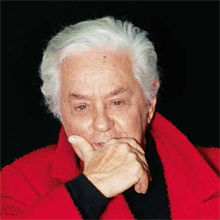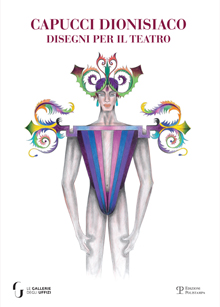Ricerca Veloce
Ricerca Avanzata

Roberto Capucci
Roberto Capucci nasce a Roma il 2 dicembre 1930. Frequenta il Liceo Artistico e l’Accademia di Belle Arti dove studia con i maestri Mazzacurati, Avenali e de Libero e nel 1950 apre il suo primo atelier. Il debutto internazionale avviene nel 1951 quando presenta sue creazioni presso la residenza di Giovanni Battista Giorgini a Firenze, inventore della moda italiana.
A soli 26 anni è un designer della moda italiana, particolarmente apprezzato da Christian Dior, che in un’intervista a Vogue lo definì “il miglior creatore della moda italiana”, per l’originalità delle sue creazioni. Nel 1958 crea la Linea a scatola, una rivoluzione dal punto di vista tecnico e stilistico, per cui riceve a Boston l’Oscar della Moda Filene’s Young Talent Design Award come migliore creatore di moda, insieme a Pierre Cardin e James Galanos. Il successo delle sfilate parigine del 1961 lo porta ad aprire un atelier in Rue Cambon a Parigi, ricevendo critiche positive da parte della stampa e l’onore di essere il primo artista italiano a cui sia stato chiesto di "firmare" un prodotto. Il 1968 vede il suo definitivo rientro in Italia, a Roma, nell’atelier di via Gregoriana e, nello stesso anno, disegna i costumi per il film Teorema di Pier Paolo Pasolini. Nel luglio del 1970 presenta il suo lavoro al ninfeo del Museo di Arte Etrusca di Villa Giulia a Roma, con una collezione che rivoluziona la tradizione delle sfilate: modelle con tacchi basso, senza trucco e con i capelli al naturale. Inizia la grande sperimentazione del Maestro, con l’inserimento nelle collezioni di elementi decorativi rigidi e strutturali, materia ricca e povera, tessuti pregiati, sassi e paglia. La sua stagione espositiva inizia nel 1990 con la mostra Roberto Capucci l’Arte Nella Moda - Volume, Colore e Metodo in Palazzo Strozzi a Firenze e viene accolto nei musei più importanti del mondo, tra cui il Kunsthistorihsches Museum (Vienna), il Nordiska Museet (Stoccolma), il Museo Puškin delle belle arti (Mosca), il Philadelphia Museum of Art, la Reggia di Venaria Reale (Torino). Con l’Associazione Civita, crea la Fondazione Roberto Capucci, nel 2005, con lo scopo di preservare il suo archivio di 439 abiti storici, 500 illustrazioni firmate, 22.000 disegni originali e una rassegna stampa completa.
Roberto Capucci è considerato e riconosciuto a livello internazionale come uno dei più grandi designer del XX secolo ed ha vestito grandi celebrità del mondo del cinema, del teatro e dell’alta società italiana ed europea.
Roberto Capucci (born December 2, 1930 in Rome) is an Italian fashion designer. He created unusual, sculpted dresses in original materials, bewitched the fashion world and has, since his debut, been featured in shows representing most talented and renowned designers. Capucci attended art school and Accademia di Belle Arti, where he studied with the artists Mazzacurati, Avenali and Libero De Libero. In 1950 he opened his first atelier in via Sistina and in 1951, for the first time, he showed his creations at Giovanni Battista Giorgini’s Villa in Florence. Only 26 years old, he was considered the best designer of the Italian fashion, particularly appreciated by Christian Dior, and in 1958 he created the “Linea a Scatola” (Box Line), a real revolution. For this innovative proposal, he received, in 1958, the Boston Fashion Award (Filene’s Young Talent Design Award) as the best creator of fashion along with Pierre Cardin and James Galanos. In 1961, Paris fashion shows, he was welcomed with enthusiasm by French critics. For this reason he opened, in 1962, his atelier in rue Cambon in Paris. In 1968 he returns to Italy where he showed his collections during the fashion calendar organized by the Camera Nazionale dell’Alta Moda and, in the same year, he draws costumes for Silvana Mangano and Terence Stamp for Pier Paolo Pasolini’s movie “Teorema”. In July 1970, he showed his work in Rome, at the Nymphaeum of Museo di Arte Etrusca at Villa Giulia, with a collection that revolutionized the tradition of fashion, with models wearing boots with low heels without make up and hair styling. He began his experimentation with the inclusion of decorative, rigid and structural elements, in a mix of rich and poor material, precious fabrics, stones and straw. With the exhibition “Roberto Capucci l’Arte Nella Moda - Volume, Colore e Metodo” in 1990 at Palazzo Strozzi in Florence, his explosive season began with big praise of critics and audiences in the most important museum of the world, including Kunsthistorisches Museum (Wien), Nordiska Museet (Stockholm), Puskin Museum (Moscow), Museum of Art of Philadelphia, Reggia di Venaria Reale (Turin). In 1995 he was invited to show his creations at the Esposizione Internazionale di Arti Visive. La Biennale di Venezia, at the edition of the century 1985 -1995. In 2005, with the Associazione Civita, he founded the Fondazione Roberto Capucci to preserve his archive of 439 historical dresses, 500 signed illustrations, 22.000 original draws and a full press release. In 2010 he collaborates with artists Maurizio Martusciello and Mattia Casalegno in the audiovisual installation ’Il Gesto Sospeso’, commissioned by FENDI and premiered at the Hadrian Temple for the Rome Fashion Week. Roberto Capucci is considered one of the most important designers of the 20th century.
Vedi anche...
Capucci dionisiaco
- € 26,60
- € 28,00
